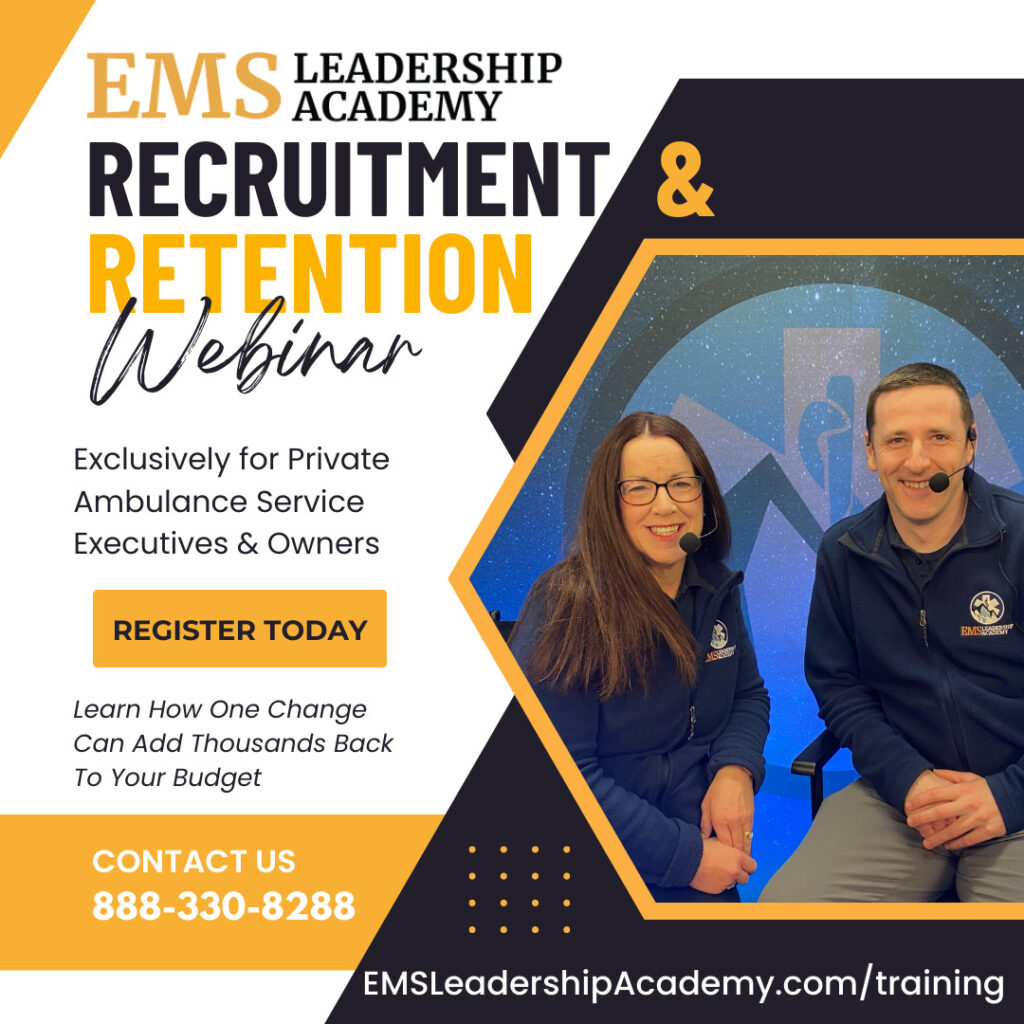Recruitment and retention are by far the topics we get asked about most often at EMS Leadership Academy. It is understandable because it is a pervasive issue that is threatening the viability and stability of EMS organizations around the world. Recruitment and retention are usually talked about in one breath as if they are one problem, inexorably linked and impossible to solve.
EMS Leaders have offered a multitude of explanations for the recruitment and retention problem such as low pay, young people don’t want to volunteer or make EMS their career, this generation is too entitled, can’t find good help anymore, EMS is a stepping stone to other health care careers so people don’t stay. We could go on and on. Not surprisingly, none of these explanations have made any difference in solving the problem.
In my experience, there is an innocent misunderstanding at the heart of the issue that has caused recruitment and retention to be such an overwhelming challenge.
Recruitment and retention are not the problem.
They are the result of the real problem, which is hidden in the background wreaking havoc, creating the revolving door syndrome - spitting people out of the organization as quickly as you bring them in. The current way of approaching recruitment and retention has EMS leaders focused on the wrong thing - finding the “right” people.
Consider that recruitment and retention is not an individual phenomenon. It’s not about finding the right people or fixing an individual. Imagine, if you bought an expensive rosebush and then planted it in a parking lot. It would likely die and there’s nothing you can do about that. But if you take that really expensive rosebush and you find out what kind of food it needs, how much water and sunlight it needs, -- if you pay attention to the environment that rosebush will likely thrive. It’s the same for human beings.

“A farmer does not grow crops. A farmer creates an environment where crops can grow.”
If you want to solve the recruitment and retention issue, you have to see it for what it is - a result of the culture of your organization. PERIOD. The culture of your organization is the environment you are growing your people in. If your culture is toxic it will negatively impact even the best performers.
What is Organizational Culture?
The values, beliefs, norms and assumptions of the organization that underlie the way things are done in an organization. The culture is what informs and shapes the actions of the individual members. The culture of an organization is like water to fish, so pervasive it’s not seen. It’s all there is, so it’s difficult to distinguish. Once you are clear that the results you have are directly correlated with your culture it becomes easier to see.
Most organizational cultures come about by default. In other words, the organization got designed around the problems or issues it was facing rather than for the results it wanted to create.
If you want to change the outcome or results of your organization such as recruitment and retention, you must first and foremost change the culture. As Peter Drucker says, “Culture eats strategy for breakfast.”
Guess what is the number one influencer of a culture? The leadership of the organization!!
This is extremely good news. It means you, as a leader, have the ability to alter the culture of your organization to attract highly engaged long-term members or employees; It’s within your power to create and maintain the culture and organization you most desire.
Due to the misunderstanding of “looking for the right people,” EMS Leaders typically focused their attention on recruitment. When you understand that this is about the culture of your organization it shifts your focus to retention, i.e. keeping the best people. Once you design your organization to keep the best people it will naturally attract more of the best.
How do you keep the best?
By intentionally designing your organization for the outcome (results) you want rather than trying to avoid what you don’t want. Consider this example, ambulances were originally designed for speed because the goal (desired outcome) was to get the patient to the hospital as quickly as possible. Later, when the desired outcome changed to getting emergency treatment to the patient, the design of the ambulance changed in line with that new goal.
Start with the end in mind.
Remember that this is a design problem, so you need to be clear about what the desired outcome or result is that you want for your organization. What do you want to create? It is important to be as specific as possible. For example, “wanting more qualified medics” is different than “highly engaged, life-long employees/members of an elite team.”
A vivid image of the future
compels the whole body.
Once you have clarity about what you are creating, then it’s time to design structures and procedures in line with that outcome. Asking questions of yourself, other leaders and individuals within the organization such as, “How do we design our organization to produce that result? What structures do we need to create and what structures do we need to eliminate? What’s the smallest action we could take to move in this direction?
Be curious and have a learner’s mindset.
It is essential to approach the design problem with curiosity and be willing to not know the answers. If you assume you know what it takes to retain your best people you will miss out on what’s important to them. Interview your best people and truly listen to their answers. Find out what attracted them to your organization, what’s important to them, what do they need from the organization and what do they see is missing, what ideas do they have for structures and procedures to implement to create the results that you are committed to?
Be the kind of leader people want to follow.
What kind of leader are you? Predictably, when people are asked this question they answer with a list of characteristics or qualities. Consider, leadership is not a particular set of qualities. Leadership is a willingness to stand for an outcome and ensure it occurs no matter what. Leaders don’t blame circumstances or other people or themselves for the results. Leaders take 100% responsibility for the outcome. Leaders know they either did or did not do what was necessary to achieve the result; no story, reason or blame needed.
Leaders know their number one job is to develop the people they are leading. Developing people is the context for everything a leader does from delegating tasks to resolving conflict to providing corrective feedback and everything in between. Leaders are good coaches who see everything as opportunities for growth for themselves and for the people they lead.
Leaders see the best in their people and help their people to see the best in themselves; reaching for greater challenges and striving for more ways to contribute. Leaders focus on and leverage the talents and strengths of their people and create opportunities for them to shine. Weaknesses are also addressed and developed; however, they are not the center of attention.
Imagine it from scratch.
As you start to re-design your organization, pretend it is a blank canvas - no barriers, no problem people who won’t get on board, no financial woes, no higher ups who will prevent you from implementing your ideas - nothing but a blank canvas. Give yourself some time to imagine it the way you truly want it to be without compromise. Allowing yourself this space will enable you to engage your creativity without getting sideswiped by your opinions and assessments about how it is.
It isn’t necessary to actually design your organization from scratch in order to transform your culture, but it is helpful to imagine it from scratch to gain clarity on what you really want. Stepping away from your perception of the situation will clear your mind. Human beings are amazing creators. When you give your mind the opportunity to slow down and ponder a situation, solutions become apparent. If you’ve ever been stuck in a dilemma and walked away to do something else, then suddenly out of nowhere the answer to the dilemma pops in your head you will see the power in what I am suggesting.
Honestly, if the only thing you did differently out of reading this article was to see recruitment and retention as an outcome of your organization’s design rather than a problem to solve, you would have a greater ability to impact it. Don’t be satisfied with the standard reasons given; be willing to see the context in the background (your organization’s culture) as the true culprit and get curious about what else is possible.




This is a great article. Really hits home.